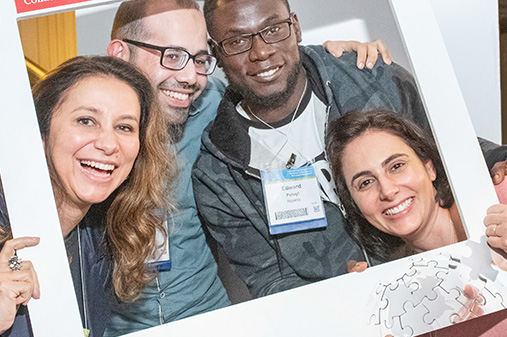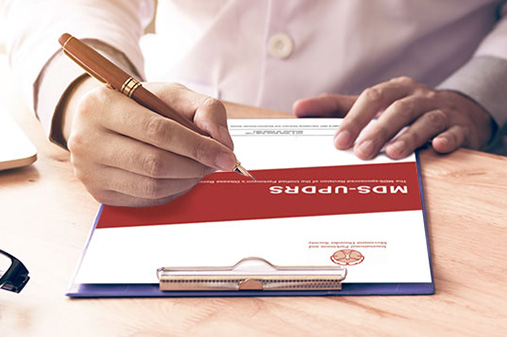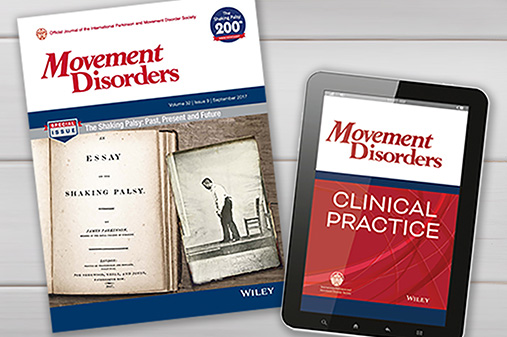Hot Topic: Subcutaneous levodopa infusion
[00:00:00] Dr. Hugo Morales Briceno: Welcome to another episode of the MDS podcast, the official podcast of the International Parkinson and Movement Disorder Society. I'm your host, Hugo Morales, and in this Hot Topic episode, we're diving into an exciting breakthrough in device assisted therapies for Parkinson's disease. Subcutaneous, continuous levodopa infusion.
View complete transcript
The management of Parkinson's disease is still evolving, and recent clinical trials have proven just how far we have gotten. Back in 2019, a randomized controlled trial study showed that false levodopa, false carbidopa, a prodrug of levodopa carbidopa, delivered via continuous subcutaneous infusion, significantly improved motor fluctuations. Giving patients more on time without troublesome dyskinesia and reducing off time.
Now fast forward to [00:01:00] 2024, another clinical trial confirms that subcutaneous levodopa carbidopa when combined with oral therapy enhances on time and further minimizes those challenging off periods. These groundbreaking studies, both published in Lancet Neurology, mark a major milestone.
Subcutaneous levodopa infusion is officially a proven option for managing motor fluctuations when oral dopaminergic therapy alone itself is not enough. To unpack what this means for clinical practice, I'm thrilled to be joined by Dr. Ray Chaudhuri, professor of movement disorder and director of the Parkinson's Foundation Center of Excellence at King's College, London. Welcome, Professor Chaudhri.
[00:01:46] Prof. Ray Chaudhuri: Hello. Delighted to be here today.
[00:01:49] Dr. Hugo Morales Briceno: It's a pleasure to have you here. Now, Professor Chaudhuri, you have had extensive experience with infusional and surgical device assisted therapies for Parkinson's. [00:02:00] Let's start with your view on what makes subcutaneous levodopa infusion an attractive therapy.
[00:02:06] Prof. Ray Chaudhuri: Subcutaneous levodopa infusion probably is one of the most significant advances we've seen. in the last, I don't know, 20 years or so, in the management of Parkinson's. And this is because we've been working on it for many years, to looking at alternative ways of delivering levodopa, because levodopa still is the gold standard of our pharmacological treatment for Parkinson's.
And oral levodopa, which is the mainstay, is faced with many problems, mainly due to the barriers of the gastrointestinal tract. We have the inevitable problems as the condition progresses of Parkinson's that you get delayed gastric emptying, erratic absorption from the jejunum because of the tablets taking longer time to reach the absorption site.
But also there are interactions with food, particularly dairy or protein, possible interaction with [00:03:00] bacteria such as Helicobacter pylori, etc. An alternative route that seems optional and feasible and can provide 24 hours therapy, which is another thing that's an unmet need really in Parkinson's care is through subcutaneous route.
And finally this has now been made available. So we have this great translation of all the research from bench now to bedside so we can bring this to clinical care for all our patients.
[00:03:29] Dr. Hugo Morales Briceno: Now, in clinical practice and how you sort of saw these patients in the clinical trials and now as a real world experience we know that Parkinson's itself is very complex and every patient has their own way to have the motor fluctuations a combination with wearing off dose failure dyskinesia so it's very complex, but at the end these patients have impairment in their quality of life. But based on your experience and expertise and the use of subcutaneous [00:04:00] levodopa, what kind of patient profile in terms of age, type of motor fluctuations, and even non motor symptoms do you think would benefit from this therapy?
[00:04:13] Prof. Ray Chaudhuri: It's a great question. Would need a long answer, but I think it's best to start with the relative novelty of this strategy, which you alluded to before. First we have, this is, of course, we're talking about what we call in the UK, Proto Dopa, origin developer at the ABV 951, which is actually foslevodopa and foscarbidopa infusion.
And they are pro drugs and they are converted into levodopa and carbidopa as soon as you initiate the subcutaneous infusion. Now the great advantage of this strategy, which will then take us on to the patient profile is that A, this is really a replacement of all [00:05:00] levodopa containing medication the patient might be taking as well as COMT inhibition.
Secondly, there is no effect of food or diet on this infusion, which is a great problem with oral therapies, particularly oral levodopa. Thirdly, we can give it for 24 hours, which is again, apart from deep brain stimulation, at this moment in time, we don't really have any other 24 hours therapy.
Apomorphic infusion can be given 24 hours, but it's very selective, very labor intensive, and only possible in very few selected centers, so I would not consider that as a regular physical option. And finally, it's delivered through a very state of the art modern pump. The diffuser pump, which is lot lighter than perhaps many people will be familiar with duodopa. The Levodopa infusion into the jejunum where you have a much larger pump. The pump is about 500 grams compared to the diffuser, which is about 240 grams. So there are these clear [00:06:00] advantages of this infusion system. That means that the patient groups that you can include are very wide. See, this therapy therefore, and in our clinical practice, we've seen this, is any patient whose oral therapies are no longer really working conventionally.
Now, you can either go by your clinician's discretion. Most of us clinicians in movement disorders will know when a patient is having random fluctuations, motor fluctuations, non motor fluctuations, or dyskinesias. Or the drug time to on is very significantly prolonged, etc. The duration of treatment is short.
Or you can go by an established criteria. By some people use the so called 5 2 1 criteria. 5 dose of levodopa, 2 hours of off period, one hour of troublesome dyskinesia along with non motor symptoms and functional disability. This was developed originally through a Delphi consensus [00:07:00] coordinated by Angela Antonini and others.
So you can use that criteria, the so called managed PD tool, or you can use your clinical criteria, but the proto-dopas should be at least tried in all these range of people. So age is not a barrier. That's a great thing because with deep brain stimulation, you have an age restriction in most centers.
Yeah, we have used in a lot of people over the ages of 70, for instance, with great effect. Secondly, you can provide 24 hour care, so patients who might have significant nighttime problems are particularly also eligible. And when I say nighttime problems such as significant early morning off periods, they're waking up very significantly troubled in the morning, either with difficulty in movement, emergence of bad tremor, significant non motor problems such as depression, pain, dystonia as well as urgency of urination.
So early morning off is a very clear indication, and we now know [00:08:00] that it is one of the most untreated aspects of Parkinson's care. We are very good with daytime care, but often the nighttime care is not that adequate. And have shown in our studies and many others that early morning off or early morning akinesia has a significant effect on patients quality of sleep, but also their daytime functioning.
So that is one of the targets in my practice, and I know many people who are working with us or others now use specifically nighttime disability as a potential indicator also to help with proto dopa therapy, particularly early morning akinesia. More recent data also suggests a very good beneficial effect on nocturia.
Nocturia has been consistently cited as one of the most troublesome non motor feature and non motor epidemiological or prevalent studies way back from 2010. Yet we don't have very good treatment for nocturia. But I think this continuous drug effect through the night [00:09:00] Avoiding the nocturnal off period and off related urgency of urination, as well as potentially effect on the D1 receptor mediated effect on the bladder might all help with the symptoms of nocturia.
You can see therefore the patient group that will be suitable for this. Obviously with a wide patient group from young onset, early onset Parkinson's to late ages. Number two, people with inadequate control on oral therapies or transdermal therapy with the transdermal patch. Number three, people with significant non motor fluctuation as well, not just motor fluctuations.
And that can be graded by various tools that are available now, including the MDS NMS, which has a specific non motor fluctuation, eight item related questions. Then sleep. People who have impaired or significant sleep impairment due to early morning akinesia and nocturia, [00:10:00] in particular, can be all included in this concept.
So very wide range of patients, which is another beauty of this therapy.
I also should say that another great advantage of the currently available foslevodopa, foscarbidopa infusion is the pump has dual settings.
So you can have high dose during the day. And a low dose setting at night. And this is really very important for people to be aware. Because the dose often needs to be lowered at night. And if it is not, many patients or some patients might develop hallucinations. Which has been reported as a side effect in many of the trial when this was not possible.
So it's just to be aware that if a patient who started on this treatment developed neuropsychiatric complications, particularly psychosis or hallucination, it is not also an indication to stop treatment, but to be aware, reduce the nighttime dose as much as possible. And often that will help.
[00:10:57] Dr. Hugo Morales Briceno: If I could ask Prof. Chaudhuri, [00:11:00] do you use a 30 percent reduction of the daytime rate or is it 50 percent in some cases?
[00:11:09] Prof. Ray Chaudhuri: I would go with 20 to 30%. In some cases you might have to go even up to 50% if required, but usually 20 to 30%. Yes.
[00:11:19] Dr. Hugo Morales Briceno: That part of the improvement of nocturnal symptoms and with the therapies, but also to clinicians to recognize that aspect of the patient symptoms is a great tip and I think I agree with you this often missing and when we interrogate patients about the symptoms, but treating the night symptoms.
Yeah. It'll improve daytime symptoms as well. It's a great tip. Now there's other devices to therapies, as you mentioned, the apomorphine infusion, levodopa, carbidopa, intestinal gel infusion, and the deep brain stimulation, and the studies that you've been involved in the oral ENT-1 and [00:12:00] 2, they all show that improved quality of life, and it's seems like subcutaneous levodopa is offering the same sort of degree of improvement, but how do you see a subcutaneous levodopa or false levodopa carbidopa in the sort of level introduction of this devices to therapy at the patient level?
For example, some centers may prefer the use of deep brain stimulation because they're more equipped or have more experience. Other centers use infusional therapies so do you think that ldo infusion should be tried in patients before deep brain stimulation or instead of LCIG?
What is your view on this?
[00:12:42] Prof. Ray Chaudhuri: So you have raised another very important question, and I think we are going to see a slow change in our treatment paradigm, perhaps even at some stage, it will make it through guidelines. I'm aware already some potential expert opinion driven guideline [00:13:00] paradigms have already been published.
And for instance, we've done some work on this with our colleagues in Poland led by Karolina Poklowska, and we published where subcutaneous false levodopa, false carbidopa may actually fit in. So firstly, I'm of the view, given that this is a levodopa derived therapy, and given that there is a potential that you can achieve monotherapy with this, and that is similar to the Duoglob study the LCIG Cosmos study published by Fasano and others showed that up to 35 percent with levodopa intrajejunal infusion, can achieve monotherapy.
Similar data is available also with foslevodopa and foscarbidopa. So given that we have all of those data, and it's one year safety data now is also available, I have no issues with people trying to think about starting this earlier in the disease process. Indeed. There is [00:14:00] also not a totally agreed, but proposed criteria of early advanced Parkinson's.
So these are patients with, at earlier stage, disease duration wise of their Parkinson's, but may not satisfy all the advanced PD criteria. In those patients, when foslevodopa, foscarbidopa may be appropriate to use, although the national guidelines may not say so. So my view is that clinicians in the future will increasingly look at this as their primary option first before levodopa LCIG infusion, because that involves a surgery, that involves jejunal tube replacement, and use of a much larger tube, and does not give you 24 hours cover.
But certainly also, in some cases, preference to DBS. Now that will finally boil down to patient choice and how the information is given to the patient. You mentioned a very important point that there's always a center based [00:15:00] bias. Centers that are particularly good and familiar with DBS go into DBS, others go into infusion.
But then again, you have this patient group who are over 70 years of age where this therapy will become the treatment of choice. And its attraction being the 24 hour therapy. Obviously, one needs to have the maintenance of the therapy, and that's another question that perhaps we can address in terms of safety, side effects, and so on.
But I see a role where you will have patients being started on oral therapy after a while, variable period when they start. experiencing these oral problems with oral therapy or even transdermal therapy. Many people can't tolerate the subcutaneous reticulating patch, for instance, skin reactions, etc.
Others may have inadequate motor response. Then for subcutaneous foslevodopa, foscarbidopa, or subcutaneous levodopa appears a very reasonable option to try.
[00:15:59] Dr. Hugo Morales Briceno: I [00:16:00] agree. I mean, that's a lot of potential with this therapy to help symptoms, but also the age group as well. Let's talk about infusional therapy is coming with its own challenges, we understand that. In apomorphic infusion, for example, we have learned that subcutaneous nodules can be managed, as well as the side infusionary reaction.
There's a long experience on that, and what's happened with the subcutaneous levodopa infusion is nothing new. But in your view and in your experience with infusion, what are the key things clinicians should be educating their patients about? Especially when it comes to skincare, the infusion sites.
[00:16:39] Prof. Ray Chaudhuri: So this is again a really important point because while the concept And the initiation of the treatment is very exciting for many of us, given the first time we have subcutaneous levodopa available commercially. Maintenance and sustenance is equally important. And we are learning still early days, but [00:17:00] from what we see from the control trials, also the long term data that was published by Aldred and others, we were all part of that.
And then now, clinical observation now for almost coming up to a year from many countries, it seems like that there is a element of dropout or problems with skin reactions with subcutaneous levodopa generally. We know that's true for false levodopa, false carbidopa. We know that it's been true in the clinical trial setting with Neuroderm, another subcutaneous levodopa product.
And we also know from our long experience of using apomorphin. So the actual problem, just as you said having skin problems with subcutaneous therapy is not new. However, there is something a bit different with this therapy in that there seems to be different types of skin reactions that occurs. So you can get infusion site erythema, just a bit of redness around the [00:18:00] infusion site.
But in some cases there might even be nodules. There have been recently some publications on that in Movement Disorders from Japan and from I think from Germany. In some there have been reports of cellulitis. And in some, there's been quite more advanced infections. So this seems a little bit different to our experience from apomorphin.
Now, the causation is unclear, but it's very clear that you have to be really scrupulous about skin care when you start this therapy. Patients firstly need to be informed about the possibility of skin reaction, and more importantly, what to do, and how to try and prevent it developing further, and I know that the companies have now got very good support system available for this so that patients and the home care system have a process to regularly monitor the skin and then inform the secondary care the clinicians if there's a problem.
Now, what are [00:19:00] the basic ways to avoid it? One is that choosing your patient comes back to choice. People who have had previous problems with subcutaneous infusions or injections, say they've tried apomorphin, they've had significant skin problems, say they're diabetic and they've had problems with insulin injections, are naturally not the ideal group of patients to go on this therapy.
That's number one. Number two, patients who have unhealthy skin, either due to severe obesity or severe malnutrition, also, will need specific skin care additional to what we normally do. Such patients will also, when you select such patients, you have to be aware that we need to give specific attention.
Third, absolutely crucial is skin hygiene. And I advocate, and this is not necessarily a view that others would say, regular soap water wash. Some people say even two, three times a day of the skin to keep the area clean. And I've had very good response with [00:20:00] that generally. Then there is also the changing of the site of the infusion.
Normal recommendation is you can change it every three days, but often I'd recommend daily change. And making sure that there is a gap between where you insert the needle, so it's about 2 to 2. 5 centimeters gap between inserting the needle. Not going into the same place. And also, another very important point, and this was actually flagged up by my colleague Professor Fasano, and I completely agree with that, is that sometimes there's residual fluid left in the needle, in the tubing which is then capped if you're using the same needle, and if you're not changing the needle daily.
And if this fluid somehow drips onto the skin, it can be irritant. So you need to make sure that fluid doesn't drip onto the skin and by doing simply by this advice where you have soap water wash, avoiding the skin, the fluid dripping onto the skin, moving the [00:21:00] needles, keeping a gap 2. 5 centimeters and also there's a recent recommendation from our Japanese colleague saying that really try a 90 degree insertion of the needle to the skin.
They're actually quite, I think you can probably manage your cases very well. We've certainly had experience and I know my colleague Carolina has been using quite a lot of these patients have also reported that by using these measures the rate of skin reaction is very low and we're going to bring out a paper on this very soon.
But in addition it seems if you use that 90 degree direct angle, that is also a very good recommendation to have. Furthermore, if there is such a reaction, it doesn't mean you have to stop the treatment. You can use, some people would even recommend using some steroid ointments around that, or some oral antihistaminic, depending on the inflammation.
It seems like there's an inflammatory reaction in some cases. Now that [00:22:00] could be also patient driven. I think all of these angles will need to come into the skin care. But it is a very significant issue that we need to keep in mind, but it doesn't necessarily mean stopping treatment. It's just the initial healing problem, I think.
[00:22:14] Dr. Hugo Morales Briceno: Of course. And perhaps this is something that in the future with more experience from other centers and accumulated, experiences as well may inform the best way to reduce the infusion site reactions. Now let's move to another, a final question. Accessibility is a major issue when it comes to devices used in therapies for Parkinson's.
In your view, could subcutaneous levodopa offer a sort of more equitable solution for patients in underserved regions where other devices or therapies, for example, deep brain stimulation or LCIG may be more limited, scarce or too [00:23:00] expensive.
[00:23:00] Prof. Ray Chaudhuri: Health inequality in Parkinson's management has always been a major issue. Many of the advanced therapies are so expensive that many underserved countries cannot afford it unless they go private or people have money to do. And these are the countries where this sort of therapy is most needed because now we know the population, Parkinson's the numbers are likely to affect these countries more and more.
Africa. Parts of Asia, the number of Parkinson's diagnosis will be huge and also there's a projection for instance, early onset Parkinson's might form anything up to 30 to 40 percent of all the Parkinson's patients in India alone, for instance, and these people will need treat therapies like this.
So yes, at the moment, I don't think that the treatment is affordable in many of these countries through their natural reimbursement process of the health services. There needs to be more concerted effort on that, perhaps in conjunction with [00:24:00] the pharma companies, as well as societies such as ours, to try and bring some pressure onto the local healthcare delivery systems to see whether a discounted element of this service can be provided.
But you're absolutely right, the need for this therapy would be great in many people, in many underserved countries, whose only way of treating is levodopa. And this is levodopa therapy, but given in a more modern way. So I think this is something that, that absolutely needs to be addressed. But it's going to take time and it's going to need a lot of political persuasion.
[00:24:35] Dr. Hugo Morales Briceno: Of course. This concludes today's episode and I would like to thank you again, Professor Chaudhuri, for your insights into the practical application of subcutaneous levodopa infusion. stay tuned for our next episode where we will continue exploring the latest advancements in moving disorders.
Until then, stay curious and keep learning.
[00:24:54] Prof. Ray Chaudhuri: Thank you so much. [00:25:00]

K Ray Chaudhuri MD DSc
Kings College Hospital, London and Dubai
London, UK









